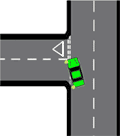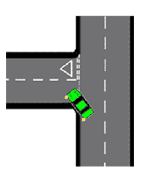 Approaching Junctions to Turn Left
Approaching Junctions to Turn Left  Approaching Junctions to Turn Left
Approaching Junctions to Turn Left
In the New Road
Once into the new road check well ahead to familiarise yourself with what lies ahead and then apply the MSM routine:
Check your mirrors to see what is happening behind (your offside mirror will help you to confirm that you're in the correct driving position).
Make sure that the signal has been cancelled.
And when you've assessed the situation in the new road make progress using an appropriate speed.
Now you'll probably want to run through that again.
We have priority in this case - the red car would be CROSSING our path so the driver should give way. But we should always be ready to react if the driver should misjudge the size of the gap and try to make the turn when they shouldn't.
Whenever we are in a situation that could result in possible conflict with other road users the golden rule is:
Priority should always be given but never taken.
Manoeuvre - Look
Now we need to Look – Assess and Decide whether it is safe to make the turn or if we will have to stop. We will have been looking throughout the approach for hazards or changes in conditions but this part of the routine is there to remind us to check that it is safe to turn. We need to check our mirrors again to ensure the situation has not changed, check again for cyclists that might be approaching on the left and also looking into the new road for any obstructions and pedestrians who may be crossing the road. If there are any pedestrians crossing the road into which you are turning you must give way to them. As we're approaching the junction we can see a red car that is also indicating his intention to turn into the same road that we are about to enter - who has priority? - click on the red car to see if you are right.
When you make the turn remember to use the pull – push method of steering and try to maintain the same distance from the kerb throughout the turn.
Manoeuvre - Speed
Once we have got into the correct position we need to adjust our speed so that we can make the turn safely. We should be assessing the severity of the turn which will affect how fast we can be moving and our speed will also be influenced by any obstructions and other traffic. We must also never drive at a speed that would prevent us being able to safely stop within a distance that we can see to be clear. We use the brakes progressively to slow to a safe speed for the turn (avoiding harsh or last minute braking), and although we need to slow down in good time we don't want to be crawling along as we approach the junction. The brake lights give supporting information to other road users of our intentions. Once we have slowed to an appropriate speed we need to select the correct gear – at this stage of your training this will normally be 2nd gear, again this should be done in good time but only once we have slowed to the correct speed and remember to allow the clutch to come fully up to avoid coasting around the corner.
If we approach the junction too quickly – this is what could happen.

Manoeuvre - Position
The first part of the manoeuvre is to take up the correct position on the road, for a left turn our position should be the normal driving position (about 1metre from the kerb) unless any obstructions necessitate us making an adjustment.
Positioning too close the kerb could result in
clipping the kerb as we make the turn.
Positioning too far from the kerb could result in us obstructing following vehicles and increase the chances of another road user coming alongside us on the left.

Signal
The next thing to consider is a signal, signals should be given in good time, but make sure the signal would not be confusing, for example if there is a road on the left before the road you intend turning into you should not signal until you are passed it. Remember also, there could be parked vehicles before we reach the road we are turning into which may require us to move out to pass them – a left signal in this case could be confusing to other road users.
Mirrors
Once you know you are going to make a turn the first thing you must do is to check the mirrors, for a left turn look in the interior mirror and the left hand door mirror, these checks should be made as soon as possible in case there are vehicles close behind who may need an early warning of your intentions. You need a complete picture of what is happening behind including any cyclists who may be on your left, you will have to slow down on the approach to the turn so a cyclist could catch up with you and try to pass on your left as you make the turn.
Approaching Junctions to Turn Left - Introduction
In previous lessons you will have been taught how to move off and stop safely and have a basic understanding of the MSM routine, you will probably also have made some turns from one road into another.
In this lesson you will be learning how to apply the MSM routine to approach junctions to turn left and right.
Terminology:
Junction – A junction is a point where 2 or more roads meet – junctions are hazards where there is a greater risk of an accident – they must be treated with care.
Approaching - is the term used when we are driving along a main road and will be turning into a minor road.
Priority at junctions is normally indicated by warning signs and road markings – if there is no indication of priority we need to take extra care.
Let's look at a vehicle turning to the left, and see how the MSM – PSL procedure is used – follow the path of the car and click on it at each stage with the cursor to see an explanation of each phase.